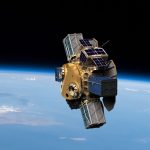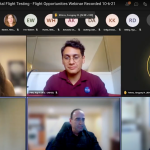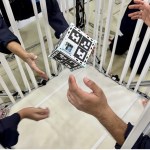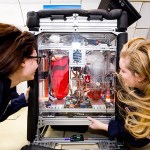FLIGHT OPPORTUNITIES COMMUNITY OF PRACTICE WEBINAR
Leveraging Suborbital Flight Testing to Advance Fluidic Optics in Microgravity
Speakers:
- Edward Balaban, Ph.D., Research Scientist, NASA’s Ames Research Center
- Wanessa Priesmeyer, Deputy Tech Lead for Integration of Automated Systems (IAS), NASA’s Armstrong Flight Research Center
November 1, 2023
Abstract
Dr. Edward Balaban, research scientist at NASA’s Ames Research Center, will discuss how he and the Fluidic Telescope (FLUTE) team used parabolic flight testing through the Flight Opportunities program, in addition to other mechanisms, to advance their fluidic optics technology. The FLUTE team subsequently received a NASA Innovative Advanced Concepts (NIAC) award, which nurtures visionary ideas that could transform future NASA missions. A collaboration between NASA’s Ames Research Center, NASA’s Goddard Space Flight Center, and Technion – Israel Institute of Technology, FLUTE addresses the need for a cost-effective solution to scale space telescopes through the creation of fluidic optical components in microgravity. He will be joined by Flight Opportunities team members to discuss technology transitions and lessons learned from multiple parabolic flight tests, as the FLUTE team gears up for another round of suborbital flight testing later this year.
Download the slides
Speaker Bios
Dr. Edward Balaban is a research scientist at NASA Ames Research Center and the NASA principal investigator for the Fluidic Telescope (FLUTE) project. His professional interests include robotics, autonomy, artificial intelligence, and development of innovative space missions. During his years at Ames, he has contributed to research and development of autonomy elements for the X-34 experimental reusable space plane, the International Space Station, robotic astronaut assistants, autonomous planetary drills, and for next-generation aircraft designs. In addition to FLUTE, he is leading strategic mission planning for Volatiles Investigating Polar Exploration Rover (VIPER) and is a member of VIPER’s Science, Mission Planning, and Mission Operations teams. He holds a B.S. in computer science from the George Washington University, an M.S. in electrical engineering from Cornell University, and a Ph.D. in aeronautics and astronautics from Stanford University.
Wanessa Priesmeyer supports NASA’s Armstrong Flight Research Center where she is the deputy technical lead for the Integration of Automated Systems (IAS) within the Advanced Air Mobility (AAM) Project. She is also a member of the technology team at NASA’s Flight Opportunities program where she works on parabolic flight campaigns, including working with commercial flight providers such as Zero Gravity Corporation, to accelerate the maturation of space technologies. She previously worked for NASA’s Johnson Space Center as an operations planner. Prior to the Space Shuttle retirement, she supported 16 International Space Station assembly flights and the Hubble Space Telescope Service Mission 4. In 2018, she was the lead operations planner for space station Expedition 56. She led the integration planning of the NanoRacks Bishop Airlock, the first permanent commercial addition to the station’s infrastructure, and she was the lead planner for SpaceX’s Crew-1 mission, the first operational crewed flight of a Crew Dragon spacecraft. In 2021, she became an integration specialist supporting the first private astronaut mission to the space station. Wanessa holds a B.S. in astronomy and a B.A. in physics from the University of Florida.


































